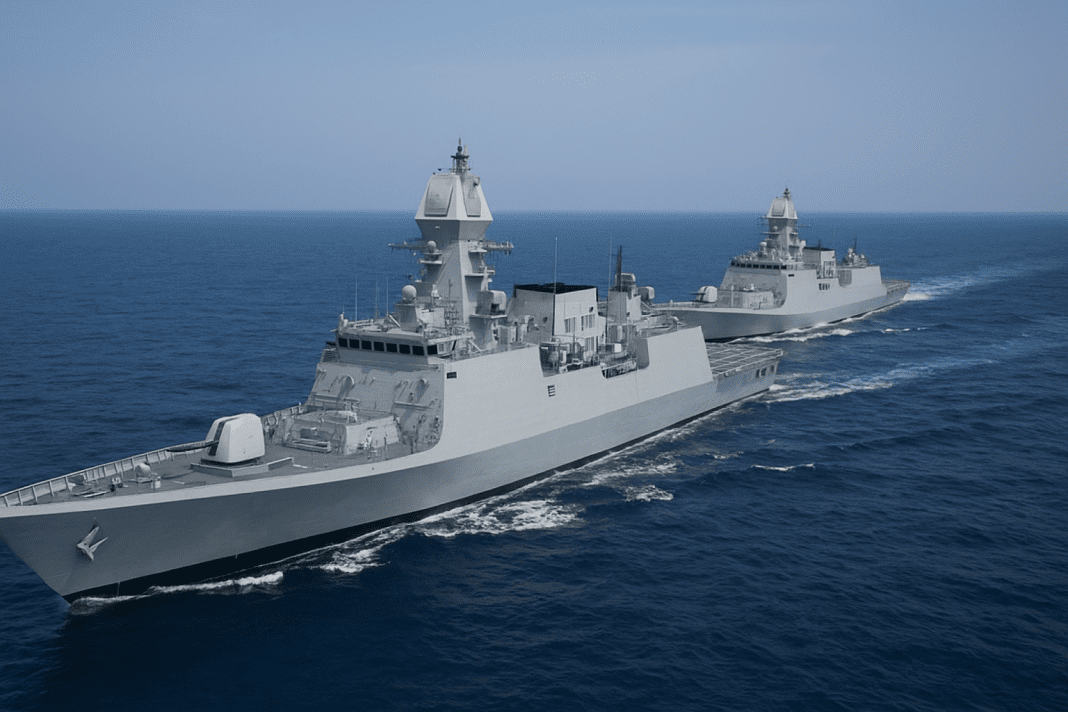The Indian Navy is preparing for a significant milestone. It will commission two indigenously built Nilgiri-class stealth guided-missile frigates, INS Udaygiri and INS Himgiri, under Project 17A. The ceremony will take place at Visakhapatnam on August 26. This is the first time that two ships of the same advanced class will be inducted together into service. It marks a rare and remarkable event in naval history.
Historic Project 17A Milestone for Indian Navy
Both warships are part of Project 17A, a major shipbuilding programme launched to modernize India’s surface combatant fleet. These advanced frigates come with stealth features that reduce their visibility on enemy radar. They carry some of the most modern weapons in the Navy’s arsenal. The project reflects a strong push toward building a technologically advanced and self-reliant naval force. It also ensures the Navy can operate effectively in modern maritime environments.
Earlier this year, the Navy commissioned INS Nilgiri, the lead ship of the Project 17A class. Now, with INS Udaygiri and INS Himgiri joining the fleet, India has taken another big step forward. These ships are developed and delivered entirely within the country. They highlight the skill and coordination between naval designers, shipbuilders, and many domestic suppliers. All of them worked together to meet strict timelines and performance goals.
INS Tushil Joins Indian Navy: A New Era of Maritime Strength
The commissioning of these two ships under Project 17A shows how far India’s shipbuilding industry has progressed. It strengthens the Navy’s operational readiness by adding more firepower, range, and flexibility to the surface fleet. It also boosts self-reliance in defence. This ensures that critical capabilities are developed and maintained within the country, while reducing dependence on foreign technology and imports.
Advanced Features of INS Udaygiri and INS Himgiri
Mazagon Dock Shipbuilders in Mumbai built INS Udaygiri. It is the 100th ship designed by the Navy’s Warship Design Bureau. Garden Reach Shipbuilders in Kolkata built INS Himgiri. It is the first Project 17A frigate constructed at that shipyard.
Both frigates have a displacement of about 6,700 tons, making them larger and more advanced than the earlier Shivalik-class ships. Their stealth design reduces visibility on enemy radar, giving them an edge in modern naval warfare.
Quad Issues Strong Message to China Over UNCLOS Violations
They are powered by a Combined Diesel or Gas (CODOG) propulsion system, managed by an Integrated Platform Management System. This setup enables speeds of over 28 knots and allows them to sail up to 5,500 nautical miles without refueling, supporting long-distance missions.
The warships carry a strong mix of weapons, including supersonic surface-to-surface missiles, medium-range surface-to-air missiles, a 76 mm main gun, close-in defence systems, and anti-submarine equipment. They carry indigenous sonar and electronic warfare technology. They also accommodate 225 personnel and helicopters. These features equip them for both combat and extended surveillance at sea.
Project 17A Boosts India’s Maritime Strength
The commissioning of these two Project 17A frigates marks a boost in India’s maritime strength, particularly in the Indo-Pacific region. Strategic waterways in this region are vital for global trade, and having more advanced warships ensures that the Navy has greater reach and operational capability.
The programme has been notable for its strong domestic industrial involvement. More than 200 micro, small, and medium enterprises (MSMEs) across the country have contributed to Project 17A by supplying critical parts, materials, and technology. This collaboration has supported over 14,000 jobs, both directly and indirectly, giving the initiative a strong economic and industrial impact beyond its military role.
INS Shivalik Triumphs at RIMPAC 2024: Milestone for Indian Navy
By inducting INS Udaygiri and INS Himgiri simultaneously, the Navy has underlined the progress achieved in shipbuilding within India. These ships demonstrate the ability of Indian shipyards to construct world-class warships that meet the demands of modern naval warfare. The induction of the frigates strengthens India’s presence across sea lanes stretching from the Strait of Malacca to the African coastline, which are among the busiest and most strategically important in the world.
With Udaygiri and Himgiri joining the fleet, the Nilgiri-class under Project 17A has gained two more powerful additions, showing how Indian design, engineering, and industry are coming together to deliver advanced platforms that are vital for maritime security.

